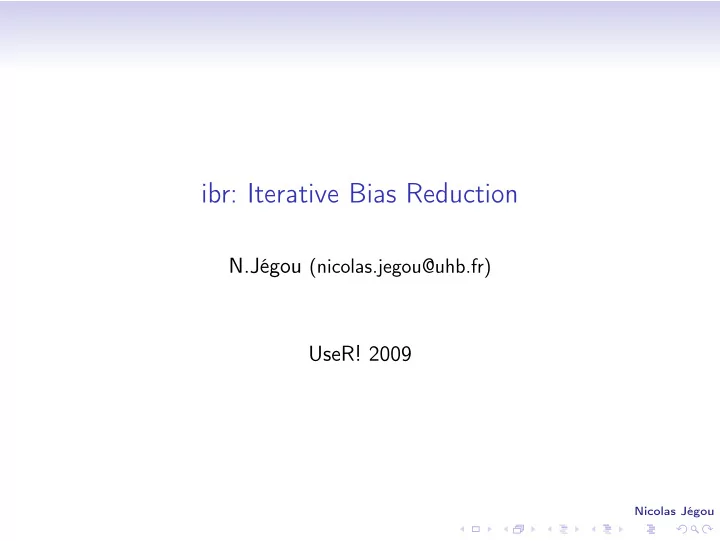

ibr: Iterative Bias Reduction N.Jégou (nicolas.jegou@uhb.fr) UseR! 2009 Nicolas Jégou
Non parametric regression model Having n observations ( X i , Y i ) ∈ R d × R from the model Y i = m ( X i ) + ǫ i , i = 1 · · · n where m ( . ) is an unknown smooth function. Nicolas Jégou
Smoothing We estimate m non-parametrically (smoothing) : m = S λ Y ˆ where S λ is the smoothing matrix and λ is the smoothing parameter (size of the bin, bandwidth, penalty...). Nicolas Jégou
Big picture Assume λ big, so that the smoother is very smooth ; then • estimate the bias • correct the previous smoother and iterate. Nicolas Jégou
Bias of a linear smoother We choose a smooth pilot S λ . The estimation is m 1 = S λ Y . ˆ The bias is B ( ˆ m 1 ) = ❊ [ ˆ m 1 | X ] − m = ( S λ − I ) m . Nicolas Jégou
Estimating the bias We replace m by its estimation : ˆ b 1 := ( S λ − I ) S λ Y . This can be written ˆ b 1 = − S λ ( I − S λ ) Y = − S λ R where R denotes the observed residuals. Nicolas Jégou
Bias correction The corrected estimator is m 1 − ˆ m 2 = ˆ ˆ b 1 = ( S λ + S λ ( I − S λ )) Y . After k iterations, the estimator is m k = [ S λ + S λ ( I − S λ ) + · · · + S λ ( I − S λ ) · · · ( I − S λ )] Y ˆ and can be written m k = [ I − ( I − S λ ) k ] Y . ˆ Nicolas Jégou
Library IBR Input parameters : • Choose the smoother : "tps" or " k ". • Choose the criterion : " gcv ","aic","aicc","bic","rmse","map". • Choose the pilot’s smoothing parameter : df. > res<-ibr(X,Y,smoother="tps",df=1.1,criterion="aic") Nicolas Jégou
Which smoother should I use ? "tps" vs "k" • smoother="tps" � ν 0 + d − 1 � ν 0 = ⌊ d / 2 ⌋ + 1 # { e . v = 1 } = ν 0 − 1 ν 0 # { e . v = 1 } d 2 2 3 5 3 21 8 5 495 • so we use smoother="k" in high dimensions Nicolas Jégou
A toy example True function : yf x1f x 2 f Nicolas Jégou
Pilot smoother res.tps<-ibr(X,Y,smoother="tps",df=1.1,iter=1) Zk<-matrix(predict(res.tps,grid),ncol=ngrid) res<-persp(x1f,x2f,Zk,...) Zk x1f x 2 f Nicolas Jégou
Selected smoother by ibr > res.tps<-ibr(X,Y,smoother="tps",df=1.1) > Zk<-matrix(predict(res.tps,grid),ncol=ngrid) > res<-persp(x1f,x2f,Zk,...) Zk x1f x 2 f Nicolas Jégou
Summary > summary(res.tps) Residuals: Min 1Q Median 3Q Max -0.094546 -0.022644 -0.002132 0.023794 0.093353 Residual standard error: 0.05373 on 26.1 degrees of freedom Initial df: 3.3 ; Final df: 23.86 gcv -4.551 Number of iterations: 482 chosen by gcv Base smoother: Thin plate spline of order 2 (with 3.3 df) Nicolas Jégou
Simulation study We will compare ibr with : • Additive models (Hastie & Tibshirani, 1995), • MARS (Friedman, 1991), • Projection pursuit (Breiman & Friedman, 1985), • L2-Boosting (Bühlmann & Yu, 2003). Nicolas Jégou
Data splitting Learning Y Y X Smoother Y Test Dataset Responses Predicted values Nicolas Jégou
Simulation results f ( x ) = a sin ( π x 1 x 2 x 3 ) + b ( x 4 − 0 . 5 ) 2 + cx 5 IBR (k,df=1.1) GAM MARS PPR gamboost ( a , b , c ) = (0.2, 10, 5) 29% 0.14 21% 379% 7% (1, 10, 5) 11% 5% 11% 139% 0.18 (10, 4, 5) 1.38 301% 117% 53% 111% (10, 1, 1) 1.19 350% 134% 21% 124% Nicolas Jégou
A real example : Los Angeles Ozone Data The sample size is n = 330 and d = 8 explanatory variables : "Pressure.Vand" "Wind" "Humidity" "Temp.Sand" "Inv.Base.height" "Pressure.Grad" "Inv.Base.Temp" "Visilibity" Nicolas Jégou
Comparing relative prediction mean square errors 80 60 40 20 0 e.mars e.gam e.gamboost e.ppr Nicolas Jégou
Download Google : • ibr + matzner • ibr + cornillon Nicolas Jégou
Comparing spread 25 20 15 10 e.ibr e.mars e.gam e.gamboost e.ppr Nicolas Jégou
Predictive smoothers Recall m k = [ S λ + S λ ( I − S λ ) + · · · + S λ ( I − S λ ) · · · ( I − S λ )] Y ˆ which can be written : m k = S λ [ I + ( I − S λ ) + · · · + ( I − S λ ) k − 1 ] Y ˆ = S λ ˆ β k . At an arbitrary location x ∈ R d m k ( x ) = S ( x ) t ˆ ˆ β k . Nicolas Jégou
Recommend
More recommend